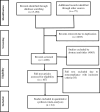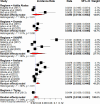Incidence of lost to follow up among HIV-positive children on antiretroviral therapy in Ethiopia: Systematic review and meta-analysis
- PMID: 38776343
- PMCID: PMC11111029
- DOI: 10.1371/journal.pone.0304239
Incidence of lost to follow up among HIV-positive children on antiretroviral therapy in Ethiopia: Systematic review and meta-analysis
Abstract
Background: At the end of 2022, globally, only 46% of children (aged 0-14 years) on ART had suppressed viral loads. Viral load suppression is crucial to reduce HIV-related deaths. To suppress the viral load at the expected level, children must be retained in ART treatment. Nevertheless, lost to follow-up from ART treatment continues to be a global challenge, particularly, in developing countries. Previously, primary studies were conducted in Ethiopia to assess the incidence of lost to follow-up among HIV-positive children on ART treatment. However, variations have been seen among the studies. Therefore, this systematic review and meta-analysis aimed to estimate the pooled incidence of lost to follow-up among HIV-positive children on ART and identify its associated factors in Ethiopia.
Methods: We searched PubMed, HINARI, Science Direct, Google Scholar, and African Journals Online to obtain articles published up to November 20, 2023. Critical appraisal was done using the Joanna Briggs Institute checklist. Heterogeneity was identified using I-square statistics. Funnel plot and Egger's tests were used to identify publication bias. Data was presented using forest plots and tables. Random and fixed-effect models were used to compute the pooled estimate.
Results: Twenty-four studies were included in the final analysis. The pooled incidence of lost to follow-up among HIV-positive children on ART was 2.79 (95% CI: 1.99, 3.91) per 100-child-year observations. Advanced HIV disease (HR: 2.20, 95% CI: 1.71, 2.73), having opportunistic infection (HR: 2.59, 95% CI: 1.39; 4.78), fair or poor ART treatment adherence (HR: 2.92, 95% CI: 1.31; 6.54) and children aged between 1-5 years (HR: 2.1,95% CI: 1.44; 2.95) were factors associated with lost to follow up among HIV positive children on ART.
Conclusions: The overall pooled incidence of lost to follow-up among HIV-positive children on ART is low in Ethiopia. Therefore, counseling on ART drug adherence should be strengthened. Moreover, emphasis has to be given to children with advanced HIV stage and opportunistic infection to reduce the rate of lost to follow up among HIV-positive children on ART.
Trial registration: Registered in PROSPERO with ID: CRD42024501071.
Copyright: © 2024 Girma et al. This is an open access article distributed under the terms of the Creative Commons Attribution License, which permits unrestricted use, distribution, and reproduction in any medium, provided the original author and source are credited.
Conflict of interest statement
The authors have declared that no competing interests exist.
Figures






References
-
- UNAIDS. Global HIV & AIDS statistics—Fact sheet. 2023 [cited 2023 December,26]; Available from: https://www.unaids.org/en/resources/fact-sheet.
-
- World Health Organazation. HIV data and statistics. 2023 [cited 2023 December,26]; Available from: https://www.who.int/teams/global-hiv-hepatitis-and-stis-programmes/hiv/s....
-
- UNAIDS, The path that ends AIDS: UNAIDS Global AIDS Update 2023. Geneva: Joint United Nations Programme on HIV/AIDS. Licence: CC BY-NC-SA 3.0 IGO. 2023.
-
- United Nations, Transforming our world: the 2030 Agenda for Sustainable Development 2015.
-
- World Health Organazation. Global HIV Programme—treatment and care. [cited 2023 October,28]; Available from: https://www.who.int/teams/global-hiv-hepatitis-and-stis-programmes/hiv/t....
Publication types
MeSH terms
Substances
LinkOut - more resources
Full Text Sources
Medical

